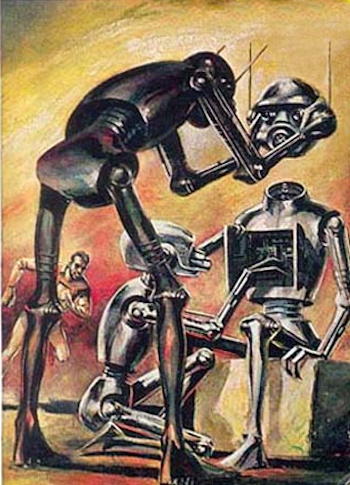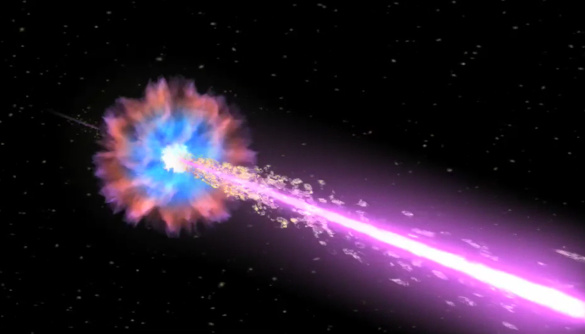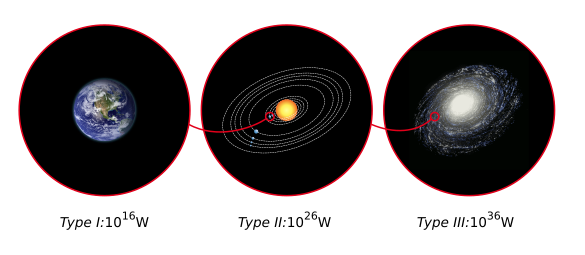The Great Filter
December 12, 2022
In the
1990s, my
colleagues and I responded to a
request for proposals (RFP) from
NASA to solve a particular
sensing problem for
booster rockets. I guess that this established my claim to the
title of
rocket scientist, but it also introduced me to
critical path analysis (CPA). CPA breaks a
project into
independent activities, determines which can be done
concurrently, which can only start when another has been completed, and identifies the critical path that determines the minimum completion time of the project. It also acts as a means of determining possible
bottlenecks in the project.
Human evolution seems to have encountered its own bottleneck, sometime between 100,000 and 250,000 years ago, in which all current
human mitochondrial DNA (mtDNA) originated from a single
population from
Africa.[1]
Mitochondrial DNA is inherited only from the
mother, through the
ovum. This discovery gives rise to the concept of a
Mitochondrial Eve, the most recent
woman from whom all humans alive today have descended in a continuous maternal
lineage from mother to mother.

An interesting research study would be the co-evolution of humans and fig leaves.
It's important to note that the Mitochondrial Eve is different from the Biblical Eve, imagined at the left, since the former was the source of mitochondrial DNA for present day humans, and this is not the same as the concept of the Biblical Eve as the first woman.
Ref. 2 has an excellent analogy of Mitochondrial Eve as the transition point between an upper and lower pyramid in which the prior human generations funnel into her from above, and future generations extend below.[2] Her special place is a consequence of her contemporaries having only sons, or no surviving children.[2]
(An 1814 engraving by J.T. Richomme based on the Raphael fresco, via Wikimedia Commons. Click for larger image.)
As our
technological society advances, we might reach a point through which humanity might not pass. The
possibility that this might be true exists in the lack of
evidence of
extraterrestrial civilizations. Those civilizations should be numerous in our
Milky Way Galaxy, and our not having evidence for even a single one might indicate that no technological civilization can pass through some critical point. This concept is examined in a recent
arXiv article that
conjectures the possibility that humanity's future might have an
existential disaster that acts as a
Great Filter, a
phenomenon that destroys civilizations before they can encounter each other.[3]
In the
1950s,
Nobel Physics Laureate,
Enrico Fermi (1901-1954), was apparently the first to identify the unexpected absence of extraterrestrials. During
luncheon conversation at
Los Alamos National Laboratory, he asked the question, now known as the
Fermi paradox, "Where are they?" Our Milky Way Galaxy should host many civilizations much more advanced than we are, and these could at least have sent
automated exploratory spacecraft our way.

If we're ever visited by extraterrestrials, the visitors most likely would be intelligent machines and not biological creatures.
It appears that even humans are on track to develop conscious machines before interstellar travel.
The image on the left is an example of machine self-replication. A downside of this process would be a gray goo catastrophe in which self-replicating machines would use all the biomass of the Earth to build more copies of themselves. This might be a possible Great Filter event.
(The cover of Galaxy Science Fiction Magazine, February, 1959, by Wally Wood, slightly modified, via Wikimedia Commons.)
An
estimate of the number of possible extraterrestrial civilizations developed to at least our technological proficiency in our Milky Way Galaxy was formulated by
astrophysicist,
Frank Drake (1930-2022). This
Drake equation was used as an estimate of the number of
communicating civilizations and possible success in the
search for extraterrestrial intelligence (SETI). Drake's initial estimate, which has been refined in the
decades since as new data have become available, had a broad
range of 1000 to 100,000,000. Some more recent arguments relating to the
rare Earth hypothesis suggest that, not only are we alone in our galaxy, but that we might be alone in the
universe. I think the presence of our large, solitary
Moon might have been a major factor in the
genesis of life on Earth.
One explanation for our lack of extraterrestrial contact might be that we're isolated from a
galactic hypercivilization since interaction would be a
detrimental to both parties.[4]
Contamination of
human culture by an advanced civilization would cause widespread dissolution of
human values and
beliefs, while the advanced civilization would suffer from a
backflow of individuals from Earth to the advanced population centers which would have negative consequences for the advanced civilization.[4] The later argument sounds like the present anti-immigration rhetoric of our
First World countries.
The Great Filter, as explained in the arXiv article, is a civilization-destroying phenomenon that explains our lack of extraterrestrial visitors and might explain the cosmic silence in our SETI searches.[3] The article identifies the
usual suspects:
• Nuclear warfare.
• Pathogens and pandemics.
• Artificial intelligence.
• Asteroid and comet impacts.
• Climate change.
All of these are well known, and possibly preventable, but noticeably absent from the list is the topic of one of my
earlier articles (GRB Extinctions, May 17, 2021); namely, a
gamma-ray burst (GRB). As early as 1997,
Greg Egan's science fiction
novel,
Diaspora, imagined a GRB destroying the
atmosphere of a
future Earth leading to mass
extinction.[5] The possibility of such an event is very real, but fortunately very small, since we live in a low
density region at the outskirts of our Milky Way Galaxy.

Artist's conception of a gamma-ray burst. Initially, a narrow beam (white) of gamma rays is emitted, followed by a wider beam (purple). (Still frame from a NASA/Swift/Cruz deWilde animation. Click for larger image.)
Supernovae emit as much
energy as the entire Milky Way emits in a few
hours, but a GRB emits in 10
seconds what the Milky Way emits in a
century.[6] A GRB within 3300
light years of Earth would destroy our
planet's ozone layer, expose
surface organisms to the
Sun's ultraviolet radiation to cause their extinction.[6] It would also produce
nitrogen compounds in the
atmosphere that would reduce
insolation and cause
global cooling.[6]
Gamma ray bursts have been detected by
satellite observatories at a rate of about one per day, but all of these have been in other
galaxies. In our own Milky Way galaxy, GRBs that have a potential to affect
life on Earth occur about once every five million years. As a consequence, life on Earth has experienced their affects about eight hundred times. A GRB may have caused the
Ordovician–Silurian extinction events about 450 million years ago in which 85% of
marine species were
extinguished.
The high
probability (95%) of
lethal bursts within four
kiloparsecs (kpc) of our
galactic center makes that region
inhospitable to life.[7] Only at the
periphery of the Milky Way, more than 10
kiloparsecs from the center, does the probability of life-extinguishing bursts drop below 50%.[7] The Milky Way Galaxy will experience a 10
40 electronvolt gamma ray burst about every billion years, and smaller bursts occur more often.[8] Gamma ray bursts would have prevented life in nearly every galaxy formed in the first five billion years of the
universe, and the The Milky Way could be among only 10% of all galaxies that can sustain
complex life for a considerable period.[8]
If we survive any such civilization-extinguishing events, what would be humanity's future? In 1964, astrophysicist,
Nikolai Kardashev (1932-2019), proposed a link between a civilization's level of technological advancement and the amount of energy accessible to it.[10] This
Kardashev scale has three
catagories, as follow:
• Type I - A civilization capable of harnessing all the energy that reaches its home planet from its parent star (1016 watts).
• Type II - A civilization capable of harnessing all the energy of its own star (1026 watts).
• Type III - A civilization capable of harnessing all the energy of its own galaxy (1036 watts).
Our attainment of a Kardashev Type I civilization might take merely the same period of time as from the
invention of the
first practical steam engine to the present day.[11]

Energy consumption associated with the Kardashev scale. (Wikimedia Commons image by Indif.)
References:
- Rebecca L. Cann, Mark Stoneking, and Allan C. Wilson, "Mitochondrial DNA and human evolution, "Nature, vol. 325 (January 1, 1987), pp. 31-36, https://doi.org/10.1038/325031a0.
- Joshua Rapp Learn, "No, a Mitochondrial 'Eve' Is Not the First Female in a Species," Smithsonian Magazine, June 28, 2016.
- Jonathan H. Jiang, Philip E. Rosen, Kelly Lu, Kristen A. Fahy, and Piotr Obacz, "Avoiding the 'Great Filter': Extraterrestrial Life and Humanity's Future in the Universe, arXiv, September 4, 2022, https://doi.org/10.48550/arXiv.2210.10582.
- Karl Svozil, "Theology and Metaphysics in Sombre, Scientific Times," arXiv, September 14, 2018.
- Greg Egan, Diaspora, (Night Shade, Reprint edition, January 6, 2015), ISBN 978-1597805421, 352 pp. (via Amazon).
- The best place and time to live in the Milky Way, Istituto Nazionale di Astrofisica (INAF) Press Release, March 5, 2021.
- Tsvi Piran and Raul Jimenez, "Possible Role of Gamma Ray Bursts on Life Extinction in the Universe," Phys. Rev. Lett., vol. 113, Document No. 231102 (December 5, 2014), DOI: http://dx.doi.org/10.1103/PhysRevLett.113.231102. An arXiv preprint is available here.
- Marc Türler, "Gamma-ray bursts are a real threat to life," CERN Courier, Jan 27, 2015.
- R. Spinelli, G. Ghirlanda, F. Haardt, G. Ghisellini, and G. Scuderi, "The best place and time to live in the Milky Way," Astronomy & Astrophysics, vol. 647 (March 5, 2021), Article no. A41, 11 pages, https://doi.org/10.1051/0004-6361/202039507. This is an open access publication with a PDF file here.
- N.S. Kardashev, "Transmission of Information by Extraterrestrial Civilizations," Soviet Astronomy (AJ), vol. 8, no. 2 (September-October, 1964), pp. 217-221, American Institute of Physics translation via the NASA Astrophysics Data System (PDF file).
- Jonathan H. Jiang, Fuyang Feng, Philip E. Rosen, Kristen A. Fahy, Prithwis Das, Piotr Obacz, Antong Zhang, and Zong-Hong Zhu, "Avoiding the Great Filter: Predicting the Timeline for Humanity to Reach Kardashev Type I Civilization," Galaxies, vol. 10, no. 3 (May 12, 2022), https://doi.org/10.3390/galaxies10030068. This is an open access publication with a PDF file
here.
Linked Keywords: 1990s; colleague; request for proposals (RFP); NASA; sensor; sensing; booster (rocketry); booster rocket; honorific; title; rocket scientist; critical path method; critical path analysis (CPA); project; dependent and independent variables; independent; concurrent engineering; concurrently; bottleneck (production); Human evolution; human mitochondrial DNA (mtDNA); population; Africa; Mitochondrial DNA; mother; ovum; Mitochondrial Eve; woman; lineage (evolution); Adam Eve after Raphael; fresco; research; coevolution; human; fig leaf; fig leaves; Bible; Biblical; Eve; artistic inspiration; imagined; modern history; present day; analogy; point (geometry); transition point; pyramid (geometry); generation; funnel; contemporary; son; child; children; technology; technological; society; probability; possibility; evidence; extraterrestrial life; extraterrestrial civilization; Milky Way Galaxy; arXiv; conjecture; global catastrophic risk; existential disaster; Great Filter; phenomenon; 1950s; Nobel Physics Laureate; Enrico Fermi (1901-1954); lunch; luncheon; conversation; Los Alamos National Laboratory; Fermi paradox; automation; automated; exploration; exploratory; spacecraft; extraterrestrials; artificial intelligence; intelligent machine; biological creature; human; consciousness; conscious; interstellar travel; self-replicating machine; machine self-replication; gray goo; disaster; catastrophe; biomass; Earth; Galaxy Science Fiction Magazine; Wally Wood; Wikimedia Commons; approximation; estimate; astrophysics; astrophysicist; Frank Drake (1930-2022); Drake equation; communication; communicating; search for extraterrestrial intelligence (SETI); decade; interval (mathematics); range; rare Earth hypothesis; universe; Moon; abiogenesis; genesis of life on Earth; galactic empire; galactic hypercivilization; no-win situation; detrimental to both parties; contamination; human culture; value (ethics); human values; belief; backflow; First World; country; countries; Casablanca (film); usual suspects; nuclear warfare; pathogen; pandemic; artificial intelligence; asteroid; comet; impact event; climate change; gamma-ray burst; Greg Egan; novel; Diaspora (novel); atmosphere of Earth; future; Earth; extinction; number density; artist's impression; artist's conception; light beam">beam; gamma ray; emissivity; emit; film frame; still frame; NASA/Swift/Cruz deWilde animation; supernova; energy; hour; second; century; light year; planet; ozone layer; lithosphere; surface; organism; Sun; ultraviolet radiation; nitrogen compound; insolation; global cooling; space telescope; satellite observatory; galaxiy; life on Earth; Ordovician–Silurian extinction event; ocean; marine; species; extinction; extinguish; probability; lethal dose; kiloparsec; galactic center; habitable zone; inhospitable to life; periphery; electronvolt; universe; complexity; complex; Nikolai Kardashev (1932-2019); Kardashev scale; categorical variable; catagory; star; watt; invention; Watt steam engine; first practical steam engine; energy consumption; Indif.